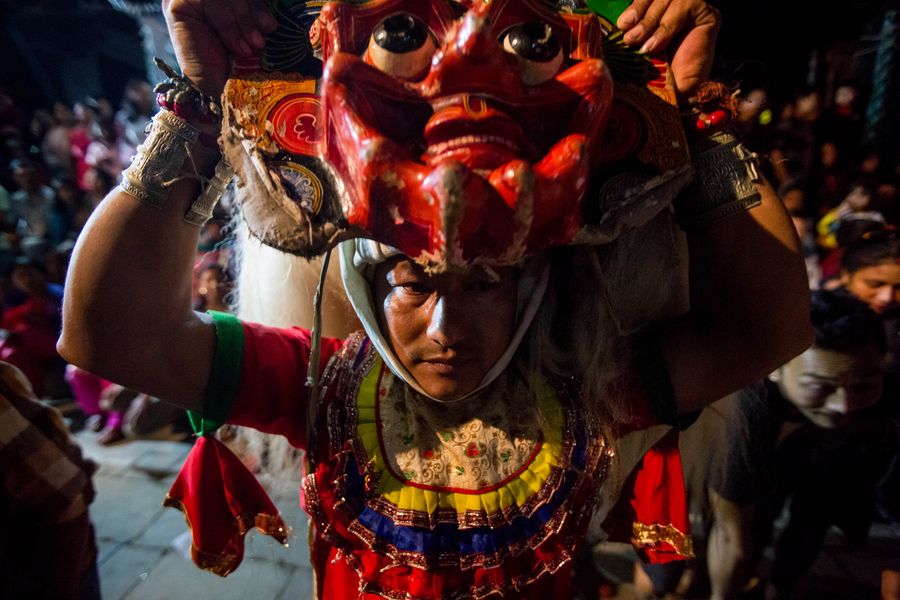
Masked dancer perform Devi dance on the last day of Indrajatra festival at Hanumandhoka Durbar Square in Kathmandu, Nepal, Sept. 17, 2019. (Xinhua/Sulav Shrestha)
"Dance is our identity," said 27-year-old Bivesh Dandeksya who started to perform the traditional dance since the age of 3.
But amid the lack of support from stakeholders, he fears the younger generations might not be able to continue the performance with the same zeal and spirit he has today.
by Shristi Kafle
KATHMANDU, Sept. 19 (Xinhua) -- Kathmandu becomes an open theater every monsoon season as people celebrate Indra Jatra, the biggest street festival in the valley dedicated to the 'god of rain' Indra, which lasts for eight consecutive days.
Chariot processions carrying living goddess Kumari along with two deities Ganesh and Bhairav along the narrow alleys and corners of the old city for three days is a major focal point of the festival.
But the celebration is incomplete without the spectacular masked dances performed in Hanuman Dhoka Durbar square every evening for a week. The dances depict different myths and stories, and showcase the cultural richness and unity within the ethnic Newar community.
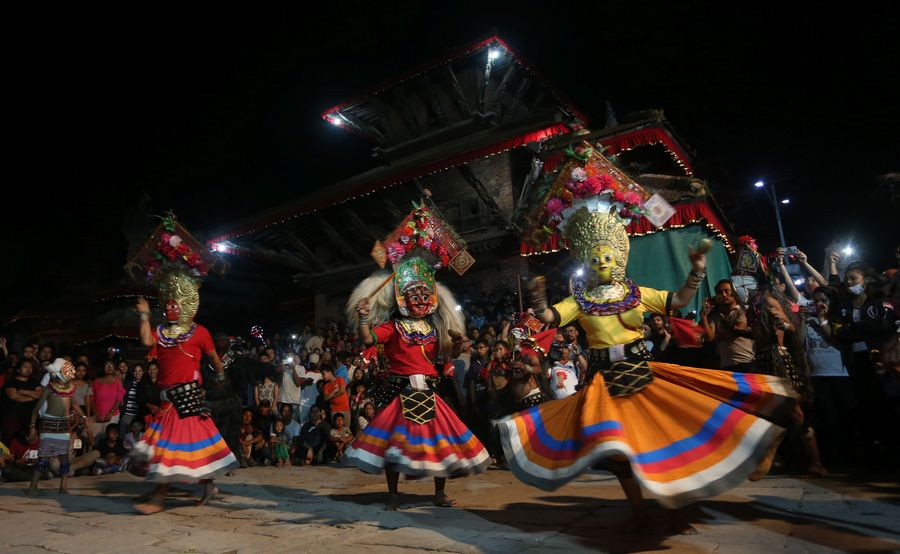
Masked dancers perform Devi dance on the last day of Indrajatra festival at Hanumandhoka Durbar Square in Kathmandu, Nepal, Sept. 17, 2019. (Xinhua/Sunil Sharma)
Among others, the colorful masked dance known as Devi or Mahakali is performed by a group of people, aged from 6 to 72 years old, belonging to the ancient city Bhaktapur. The dance is not just a center of attraction and entertainment for hundreds of onlookers, but also carries the legacy of generations.
Bivesh Dandeksya, 27, who performed the Mahalaxmi dance this year, has been participating in the age-old culture since the age of 3.
"My grandfathers used to perform this dance, as did my father, which inspired me to dance in the form of a deity. I enjoy it a lot," Bivesh told Xinhua, while getting ready in a small room of Bhadrakali temple.
To perform for over an hour with the heavily decorated head-gear that weighs nearly 7 kg and a yellow fringed dress as of a deity, is not that easy. But Bivesh said he feels no burden on his head or body, but just enjoys the whole process.
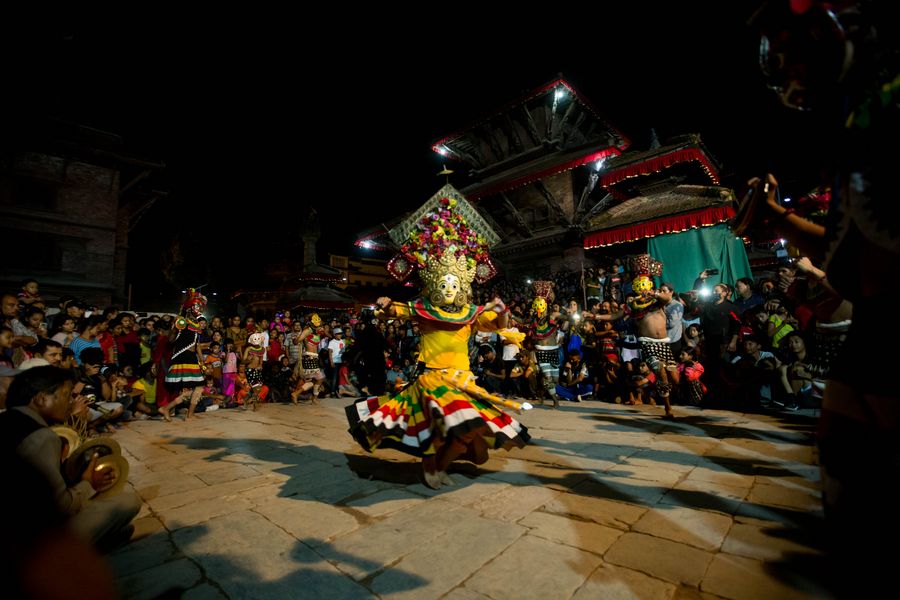
Masked dancers perform Devi dance on the last day of Indrajatra festival at Hanumandhoka Durbar Square in Kathmandu, Nepal, Sept. 17, 2019. (Xinhua/Sulav Shrestha)
"I think it's our responsibility to preserve this rich culture for coming generations," he said with determination. Bivesh performs during festivals like Indra Jatra and on other special occasions, but the rest of the time, he runs a cooperative company and does some other work to support his family.
It is believed that the dance started during the Malla Period, with the dance supported by traditional musical bands and full of fun and humor. It is performed to showcase unity and cooperation within the Newar community. Some also believe that it is showcased for the wellbeing of the public suffering from different health issues.
Though Bivesh's whole family is engaged in continuing and preserving this traditional dance, he feels sad that they don't get enough support and encouragement in return from the government or any stakeholders.
His father Tulsi Narayan Dandeksya, who performed for decades, serves as a group coordinator at present. Under his leadership, there are more than 40 performers for different dances and musical categories, all from his hometown Bhaktapur.
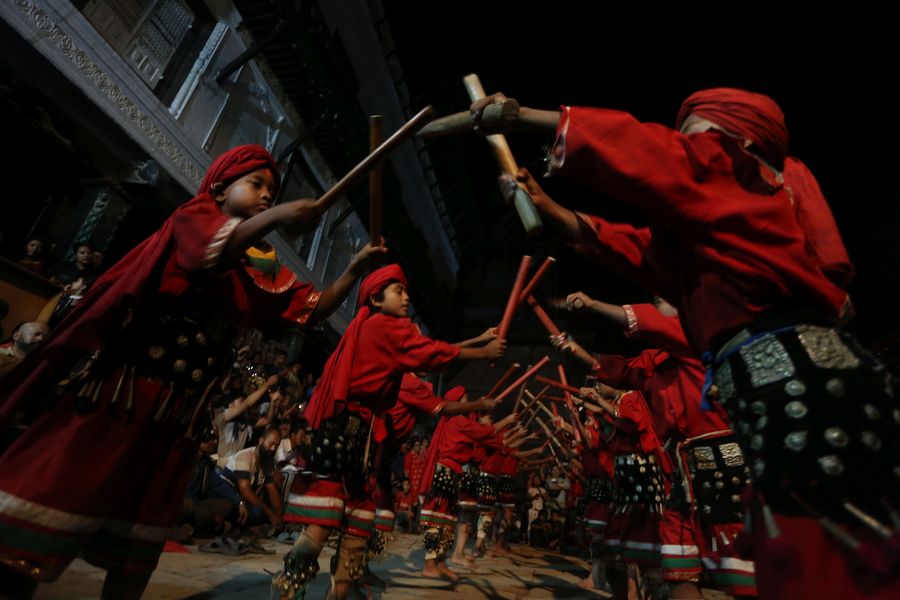
Nepalese children perform traditional Ramchandra or Stick dance during Indra Jatra Festival at the premises of Basantapur Durbar Square in Kathmandu, Nepal on Sept. 15, 2019. (Xinhua/Sunil Sharma)
"Dance is our identity. In the whole Kathmandu valley, we are the only group that has been performing this dance in Indra Jatra every year. But it is unfortunate that we don't get much support for our contribution," Dandeksya told Xinhua.
He explained that for the performance comprising a group of more than 40 people, the Indra Jatra organizing committee pays less than 400 U.S. dollars for eight days, which is far from enough to be able to cover the expenses involved.
"We need to arrange dresses and accessories, transportation and food and the amount provided is so insufficient that we cannot pay the performers. So, it's mostly like a voluntary service," Dandeksya said of the struggle.
The group hasn't received payment for last year's Indra Jatra yet. However, he maintained that they have been able to sustain the tradition by generating some occasional funds by performing at some private and commercial functions.
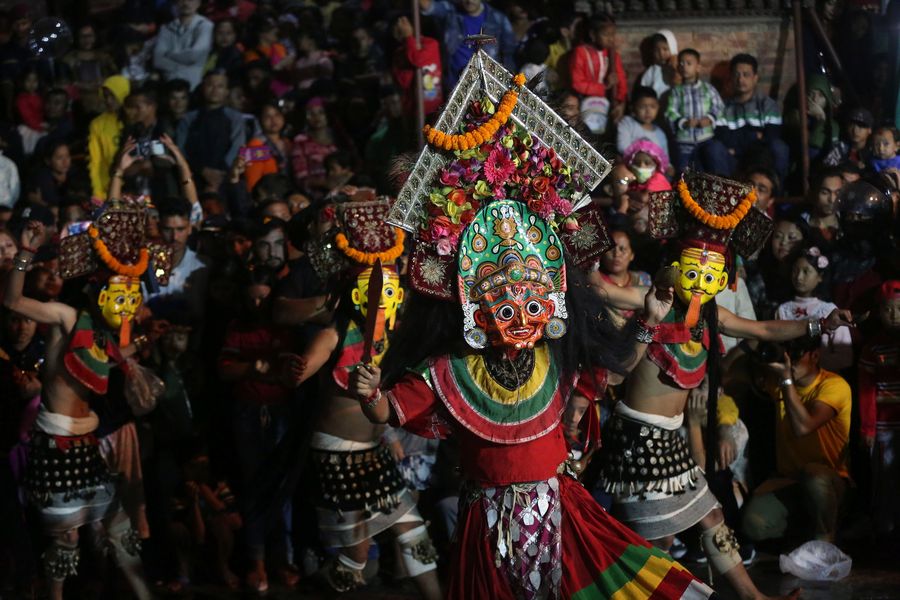
Masked dancers perform Devi dance on the last day of Indrajatra festival at Hanumandhoka Durbar Square in Kathmandu, Nepal, Sept. 17, 2019. (Xinhua/Sunil Sharma)
Being a coordinator, Dandeksya fears that the younger generations, including his grandsons, might not be able to continue the performance with the same zeal and spirit in the future, as he and his forefathers had done.
Eleven-year-old Salik Suwal is his (brother's) grandson, and has for two years been taking part in a dance called Ramchandra, which is known locally as a stick dance.
"I love to dance with friends. Our dance is called the monkey dance," Suwal told Xinhua, with a big smile while getting ready for the performance.
Suwal, however, has little knowledge about the history or significance of the dance owing to his young age.
When the dance begins in the square at dusk, people are stunned by the unique costumes, giant masks and the performances themselves, which attract thunderous rounds of applause by the audiences and appreciation from foreign tourists.
For an hour, the open platform is filled with different deities performing with enthusiasm and vigor. But when the show is over and the performers pull off the masks, they are back into reality.
"I just wish we could save this age-old dance," 55-year-old Dandeksya expressed with a hopeful gesture, standing in a corner of the square. ■



